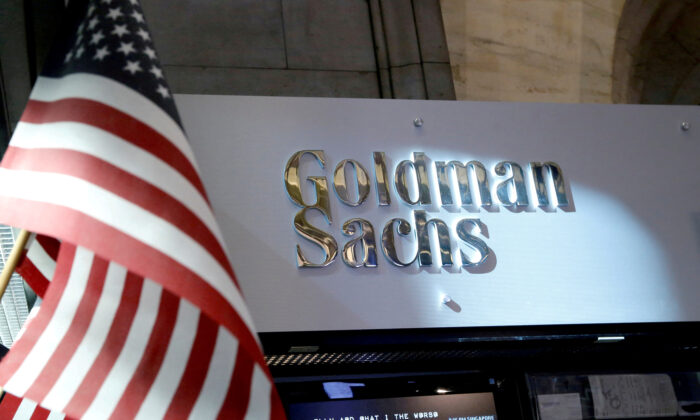DNI Tells Schiff Transcripts of Russia Investigation Can Be Released
Analysts at investment banking and financial services giant Goldman Sachs believe that U.S. economic activity has likely reached its lowest point and is primed to take off in the third quarter, according to a report聽(pdf) published this week.
Furthermore, the market-making bank stated in a note on Monday that it expects the U.S. economy to reopen gradually as lockdowns are eased and life returns to a semblance of normality for millions of Americans. According to聽Business Insider, Goldman says the recovery curve is likely to be V-shaped after mid-year and more broadly U-shaped for 2020 as a whole.
Acknowledging that the CCP (Chinese Communist Party) virus crisis has pushed the U.S. and global economies into a deep recession, Goldman outlines how annualized real GDP growth in the second quarter of 2020 is likely to be a massive minus 34 percent compared to the first three months of the year, and that official unemployment figures could still climb as high as 15 percent in the third quarter.
However, Goldman stresses that their predictions depend on how effectively states and the federal government can rejuvenate a stalled economy, and on consumer psychology with respect to spending.
Stimulus Doing Its Job
The bank’s report also sees encouraging signs that Federal Reserve policies and virus-containment measures taken by states and the Trump Administration will soon bear fruit, with the Fed expected to provide support whenever required. “We’ve increased our expectations for U.S. fiscal policy, and see another $550 billion of stimulus this year on top of the already approved $2.5 trillion, and expect a further $1 trillion over 2021-22.”
Goldman analysts believe that the stimulus package will replace much of the income lost through widespread unemployment鈥攁nd perhaps to such an extent that disposable income may actually grow overall in 2020.聽Business Insider quotes a Goldman note to the effect that “total disposable personal income will increase by 0.5 percent in 2020 relative to the pre-virus level, or $75 billion.”
Economists at the bank take account of “reasons to be cautious about the pace of US reopening, but also see some encouraging signs, such as the fact that most of the massive U.S, layoffs have so far been temporary.”
According to the report, the same analysts “assume a gradual growth recovery beginning in May that leads to a quarterly annualized increase in GDP of +19 percent in Q3 and +12 percent in Q4, albeit from very low Q2 levels, leaving 2020 growth at -6.0 percent.”
However, the analysis does come with caveats, as Goldman assumes the Fed will step in again to bring its economic life-support to over $3 trillion, or almost 15 percent of GDP.
With the Fed pumping lifeblood into the economy, Goldman analysts expect the recession to be front-loaded, with consumer spending and pent-up demand unleashed, “assuming that the physical constraints on economic activity gradually loosen towards the end of Q2.”
In the report, Goldman Sachs expressed broad support for the Fed’s approach to date. “In addition to returning rates to zero and announcing uncapped asset purchases, the Fed has employed several crisis-era facilities to provide corporates with funding, relaxed capital buffers, and reserve requirements, and activated FX swap lines with foreign central banks. We see these steps as sufficient for now to support the flow of credit in the economy, and expect the Fed to emphasize that it will intervene further if needed.”
The sentiments were broadly in line with those expressed by competitor Morgan Stanley on April 24.
Consumer Psychology Will Be Key
While Goldman Sachs analysts expect that strong, stimulus-based household disposable income will kick-start the U.S. economy, it remains unclear how consumers and businesses will actually behave until lockdowns have been lifted and Americans return to work.
A Harvard Business Review (HBR) article on marketing聽penned in the wake of the 2008 global financial crisis, however, stresses that during recessions, “consumers set stricter priorities and reduce their spending. As sales start to drop, businesses typically cut costs, reduce prices, and postpone new investments”鈥攏one of which bode well for economic recovery.
With the financial crisis still tangible at that time, the HBR researchers viewed U.S. consumers in 2009 as falling into a number of categories.
HBR believed that vulnerable “slam-on-the-brakes” consumers include those hardest hit financially, who react by reducing, substituting, or eliminating purchases. “Pained-but-patient”聽consumers are resilient and more optimistic about the wider economy, but still economize in most areas.
So-called “comfortably well-off”聽consumers are generally those who have a financial cushion to protect them from the worst effects of a recession, including wealthier retired persons as well as “people in the top 5 percent income bracket.” Such consumers tend to “consume at near-prerecession levels, though now they tend to be a little more selective (and less conspicuous) about their purchases.” The younger, urban “live-for-today”聽segment continue consuming as normal, and are “unlikely to change their consumption behavior unless they become unemployed.”
Goldman Sachs analysts say that fiscal measures such as the Paycheck Protection Program鈥攚hich helps pay eight weeks of workers’ wages for companies with up to 500 employees鈥攚ill help businesses now, and may influence consumers to worry less and consume more as the economy reopens. However, they are concerned that additional assistance may yet be required if businesses remain closed throughout the month of May.
Focus News: Goldman Sachs Bullish on US Economy, Predicts 19 Percent Growth in Q3
